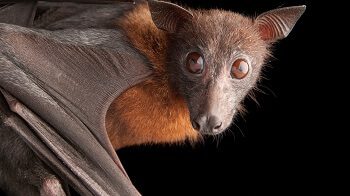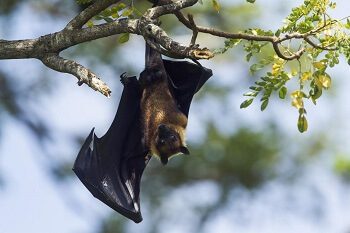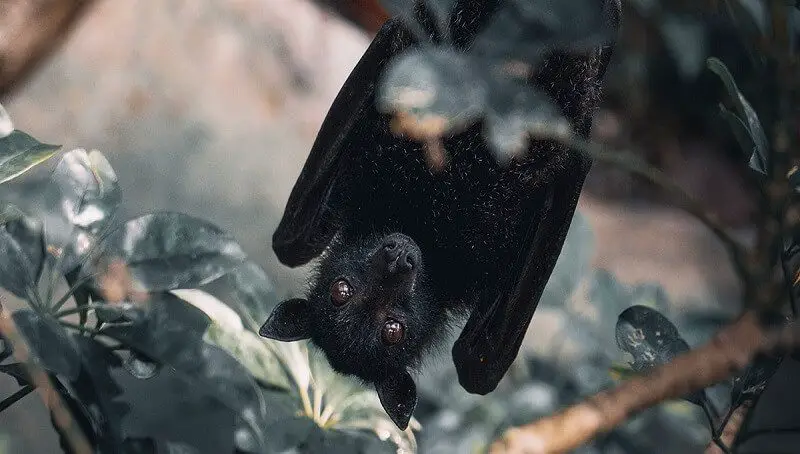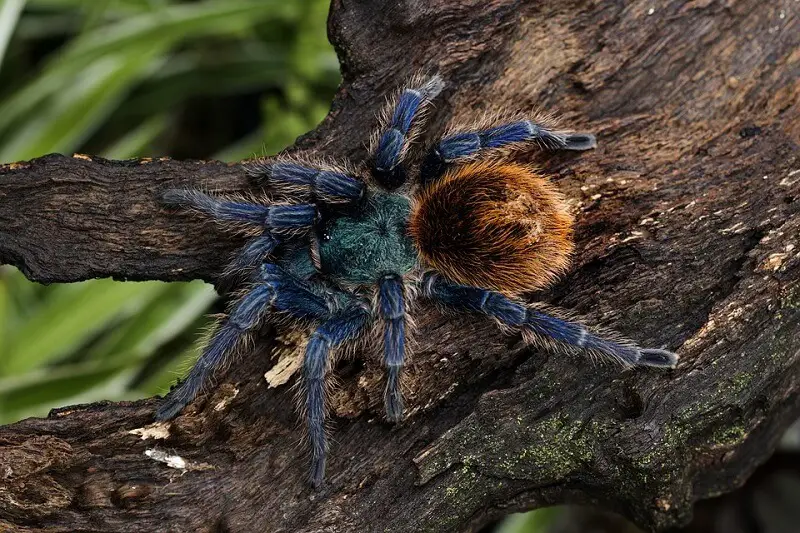Not everyone keeps at home common animals as pets. Not everyone enjoys the company of dogs, cats, decorative birds, or hamsters. Fans of unusual pets must inevitably become real experts in their care, otherwise, the animal will get sick or worse. But many are not afraid of the challenge, and such enthusiasts are becoming owners of creatures you do not expect to see outside nature. For example, a domestic bat.
Pet Bats
Bats are mammals of the Chiroptera order. They differentiate from the rest of the mammals by flexible membrane wings. Skin membranes stretch between the long fingers of the front feet, all along them and the body sides, up to the rear legs. After the flight, the wings are folded.
The rounded head and the short body are covered with thick short fur, colored reddish-brown to dark gray.
The front and rear legs have sharp claws that help them cling to the branches, rocks edges, and twigs. On the ground, bats only know to crawl clumsily.
The ears are large, wide, vital for their orientation in the air. Bats are night-time animals. When they fly to hunt, they emit high-frequency sounds that are reflected by objects and captured by their ears. Due to this skill – echolocation – the distance to obstacles is estimated, and the prey is found.
The sense of smell of these animals is sensitive. The vision is much less developed – practically it is not used at all. Eyes do not tolerate strong light.
Only fruit bats have a good view and do not use their echolocation in flight.
Most bats feed on insects. The bats from tropical forests eat fruit, fish, flowers, and blood lovers.
Contrary to the misconception, the vampire bat does not attack peopleș they feed with the blood of birds and animals, drinking about 1 tablespoon at a time.
Bats choose isolated, dark places where they sleep after a night hunt. While sleeping, they hang upside down, on their back legs. The cold season is spent in hibernation.
They give birth to cubs 1-2 times a year.
These animals live in large flocks, but at the same time, they do not unite in families. Practically, they live in the wild for up to about 20 to 40 years.
Can you have a bat as a pet?
In nature, bats live in the clefts of mountains, in caves, and in the attics of old houses. In order to meet them, you’ll have to try a lot, because these creatures are timid and avoid the presence of people.
Now imagine that you have accidentally found a bat that, as you believe, needs your help, or perhaps you just want one. Where to keep a pet so unusual? I would like to note immediately that:
You would have to offer the pet bat a spacious enclosure in which it can move freely. It will not be easy to take care of the cleanliness of the enclosure, as the bat’s fecal elimination processes take place during the flight. It will therefore be difficult to clean the flywheel.
Some bats are very easy to tame. Aggressiveness and fear in an animal can be caused by the wrong way in which you are holding it – keeping it head up will be for it as “comfortable” as for us when we are held upside down.
Please note that you will need to communicate with your pet at night – somewhere between 11 p.m. and 7 a.m., the bats are awake. Pay attention to a tamed animal, or you’ll get a depressed, lethargic animal.
You might also like our articles about tarantulas, frogs, and koalas.
If you sleep at night, their flying will disturb you with its noise. And if you release the bat in the open house, then the furniture, appliances, curtains will be covered in excrements.
Bats can reproduce if you have a lot of them keep them in non-residential spaces (old hen-coop, saffron). Adult babies will need a separate space.
These animals become ill when kept at home:
- If the temperature is not proper;
- If the bat is poorly fed. They are able to eat up to 60% of their own weight at a time. Limited activity and excess food lead to obesity and indigestion, both conditions being deadly for animals.
Do Bats Make Good Pets?
 Bats kept in captivity are not suitable for domestication.
Bats kept in captivity are not suitable for domestication.
They will not recognize the owner, even if they live in his home for a long time. They will not become full-fledged pets, because they are not adapted for such a life.
The maximum that can be reached is a positive reaction to the gentle petting of the garment.
Holding the animal with its hands in the horizontal position is not worth it; it is unpleasant for the bat and it will try to escape, biting and scratching.
Bats will gradually explore the area around their new house and will get used to it. When moving to another house, they will move cautiously at the beginning through rooms that are unknown to them.
Other pets must be kept away from getting in contact with the bat, especially when it is released to fly. The large ones are dangerous in that they can attack and try to chew the animal, and small ones will get entangled, being perceived as possible prey. In addition, bats carry many diseases, including rabies.
Do Fruit Bats Make Good Pets?
Both bats and fruit bats, flying foxes, catch roots in a home. The first is insectivorous, the second eats fruit, so it is easier for it to get proper food.
Species differ in size, color, wing size, length, shape of the nose, and teeth.
The fruit bat’s nose is elongated and makes it look like a fox.
It is very difficult to create all the necessary conditions for this animal’s full life. You must familiarize yourself with the special literature before you begin. Skilled care can usually be organized only by specialist biologists.
Can Bats Cause Damages?
A bat at home creates many inconveniences to the owner.
Its rhythm of life is opposed to that of people. During the day, the animal hangs motionless in the corner of the cage and sleeps, but at night it flies, making a lot of noise. Providing adequate nutrition and care is very demanding.
Before you take a bat in your home, make sure it is not contagious. These animals are rabies carriers and some carry some other dangerous viruses as well. If you are bitten, you must go to the doctor.
Keeping a bat at home without creating all the necessary conditions that are close to its natural habitat, will rather be torture for it. In captivity, these animals live for a much shorter period of time than in nature. Perhaps the best solution would be to abandon the idea of having such an inappropriate pet at home.
Do bats attack humans?
 Bats prefer primarily the natural environment outside towns and villages, specifically nature, caves, forests, meadows, and pastures. But the urban environment, towns, cities, villages can also attract bats, and we can meet them in attics, cellars, apartment buildings, or other locations.
Bats prefer primarily the natural environment outside towns and villages, specifically nature, caves, forests, meadows, and pastures. But the urban environment, towns, cities, villages can also attract bats, and we can meet them in attics, cellars, apartment buildings, or other locations.
The best chance of meeting these species in urban areas is during the summer and autumn periods when bats are in an intensive activity of maternity and breeding/migration. For these unexpected meetings, too, there are some simple rules that, if respected, lead to less stress for bats, but also diminishes our unpleasant experiences.
The most important thing is not to panic, because bats will not get into our hair, attack us in our sleep, won’t eat our kitchen, and won’t make their nest once they are in our house. These are only myths that can be explained and busted very easily. We must not be afraid, also because, if you’ll notice, bats are probably more scared of us than vice versa, because they have come to an unknown location, without their colony and without elements to help them find the right way to freedom.
Keep calm, it is unlikely that a bat will bite a human. However, if that happens, then you must not panic. Bats are wild animals and they do not bite because they have rabies, but because of the instinctive reaction of a wild animal. Even so, you should remember that bats can carry rabies, but the incidence is very small. A recent study showed rabies in only 11 bats out of 12.000, i.e., 0.0009%. However, if a bat bites you, it is recommended to consult your doctor immediately, who may indicate the need to obtain the anti-rabies vaccine.
How Can Bats See?
Bats can see through the echolocation, which they use for both orientation and communication and for the procurement of those delicious insects. More specifically, bats emit ultrasound at different frequencies over 20 kHz, which people cannot hear (except for silo bats, which also emit under 20 kHz). Depending on the species, bats emit ultrasound on the mouth or nose in any direction they want to scan.
If there are obstacles, walls, or insects nearby, the sounds return to the bat as echoes. Echoes are received individually with each ear. This way, the bat calculates the direction, distance, and determines the nature of the objects around it. He thus learns details of the type of area around it or the size of the insect it is going to hunt (or not). This also helps it avoid predators.
While flying fast, bats always need to avoid collisions. Otherwise, they would always hit everything around them, and that would attract the attention of owls and foxes. Usually, or most likely – because they detect and catch insects in all directions, bats seem to have a chaotic flight, different from birds. In fact, this flight is perfectly calculated.
Facts about Bats
- The bat’s wings look anatomically like a human’s hand.
- There are over 1000 species of bats.
- It’s the only mammal capable of really flying.
- They represent a quarter of the population of mammals around the world.
- About 70% of bats feed on insects, helping considerably to control pests.
- There are carnivorous bats feeding on small birds, lizards, brooks, as well as bats eating fruit or pollen.
- At the same time, some of the most spectacular bats are those who eat fish. They hunt over the water and while flying, they catch the fish with their lower limbs.
- The bat lives almost anywhere on Earth, except in the desert and polar regions.
- In a fraction of a second, using ultrasound, the bat determines the size of objects, predators, or prey, how far they are, how fast they travel, and even their texture.
- Some species of bats are solitary while others form colonies of more than 1 million individuals.
- During the winter, some species of bats migrate, others hibernate, and some of them induce a state of hypothermia that can last from hours to months.
- Depending on the species, the gestation of the bat lasts from 40 days to 6 months.
- Most bats emit ultrasound through their mouth, but there are species that emit it through their nose.
- A study found that a dwarf brown bat female consumes 600 mosquitoes per hour.
- The benefits can also be seen in fruit trees such as peaches, mangoes, figs, bananas, and dates, helping to spread the seeds.
- The African bat can “hear” the footsteps of a beetle about 1,5 meters away.
- A bat mother can find its cubs in a colony of millions of bats.
- The bumblebee bat from Thailand is the smallest mammal in the world and weighs only 2 grams.
- The vampire bats often adopt orphan pups and share food with other members.
- The blood-suckers attack chickens, pigs, cattle, horses, and other domestic animals, but not humans.
- The bat is one of the cleanest animals. It cleans itself all the time when it is not sleeping or eating.
Despite the fact that bats are protected by a number of laws, deforestation, water flow regulation, sometimes irresponsible and disinterested tourism, intensive insecticidal use, or ad-hoc renovation of buildings are jeopardizing their existence. Sometimes we are misinformed or uninformed when it comes to bats, and we believe in hair and blood legends rather than reality.
It is therefore important to leave the superstitions aside and really start to appreciate bats, both for their uniqueness and especially for their huge services.




